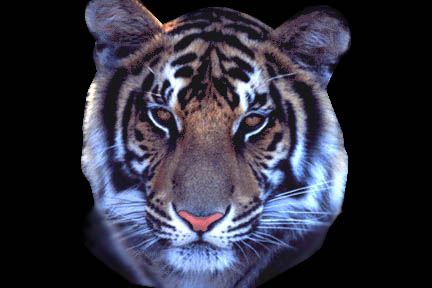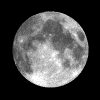| Skeptics know that this is a mere illusion -- that if anything, the moon ought to appear slightly larger overhead, since it is nearly 4,000 miles closer. In fact, an objective measurement of the angle subtended by the moon at midnight will confirm that it is nearly 3% larger. The pictures below depict what has been long known as The Moon Illusion.
The emphasis is on
psychology, of course, since objective measurements
refute subjective senses. The use of photography
and a rolled-up tube are suggested by several writers
for measuring the moon's subtension independent of
background (nobody seems to have done what I have
done, simply use a mirror to reposition the moon onto
the horizon from overhead -- or vice versa -- to
counteract the psychological factors). One
report in IBM
Research
News describes an experiment using a
laptop computer to simulate binocular depth perception
in an experiment to discriminate between competing
theories -- that the moon at the horizon is perceived
to be closer versus larger (never mind that, with eyes
separated by mere inches, binocular vision is utterly
ineffective at perceiving depth of objects beyond a
dozen feet away).
For Heaven's sake, why? In nature, every "why" question deserves four answers: Proximate, Ultimate, Ontogenetic, Phylogenetic. For an offbeat treatment of this assertion, see "Why do old men snore?" The many answers on the web to the question "Why does the moon appear larger at the horizon than overhead?" focus [no pun intended] almost exclusively on the Proximate -- explaining, for example, how images form on the retina and how the eye-brain system functions to infer dimensions and distances -- imperfectly, it turns out. If The Moon Illusion is thought to confer some fitness value, writers since antiquity do not seem to have discovered what that is. Such a conjecture would necessarily appear in an Ultimate explanation -- something of the form [deep breath here], "An individual with the trait of exaggerating the visual perception of size or closeness of objects at the horizon will enjoy an advantage that increases the likelihood of producing offspring that achieve reproductive competence." Oh sure, you sputter, but all the moon is good for is making tides and romance. Fitness value for The Moon Illusion? Hey, we're humans. We don't benefit from illusions -- moon or otherwise. On the contrary, illusions get us into trouble. Humans are in the business of dispelling illusions. We sure as hell don't need illusions to survive. Nor do our offspring need illusions to achieve reproductive competence. Drop it, for Heaven's sake.Humans we are, all right, but what's to say that The Moon Illusion is exclusively human? The moon has been around a whole lot longer than we have. Some animals -- wild or domesticated -- take note of the moon, too, perhaps regarding it as a threat. Many of today's creatures habitually howl and hoot at the rising moon in what is called an "epideictic display" -- an altruistic warning to others, convincing them to take refuge.  or survival, it is worthwhile being
sensitive to an approaching predator, which is far
more likely to appear at eye level than high
overhead. The latter, presumably on wings, would
have to be moving longitudinally to stay
aloft. or survival, it is worthwhile being
sensitive to an approaching predator, which is far
more likely to appear at eye level than high
overhead. The latter, presumably on wings, would
have to be moving longitudinally to stay
aloft. Even a primitive eye-brain system can be habituated to regard the midnight moon as nothing more than a cooler sun. Accordingly, the stealthy movements to fear most are not lateral but dimensional. Stationary but gradually expanding visual images mean "watch out!" The rising moon meets those criteria.
Here are two keys to the Ultimate explanation. First, if you're going to make a mistake when threatened with imminent predation, better to err in the direction of exaggerated bigness and closeness. The second key is to conserve energy, which means you sure don't want to waste your efforts running away from stars and clouds and -- well, the high moon. There is little fitness value in discerning subtleties in the size of objects high overhead. Any creature with an eye-brain system that conforms to The Moon Illusion would surely have a survival advantage over those with the opposite bias -- an illusion that discounts images at eye level. One author cited on the web, adjunct professor of Psychology Arnold Trehub of the University of Massachusetts, has hinted at this aspect of the Ultimate explanation. Of course, survival itself is an inconclusive outcome, but a parallel argument can be applied to individuals engaged in nurturing offspring as well as to the offspring themselves. Which leads directly to... The Ontogenetic explanation deals with the developmental emergence of The Moon Illusion. Obviously, one's visual self-deception cannot become manifest until after one's birth and some amount of practice using one's eye-brain system. It seems doubtful indeed that The Moon Illusion is taught to offspring; accordingly, genetic coding must be operative in some way to produce this particular "emergent property" -- exaggerated visual perception of size or proximity of objects at the horizon. A full explanation will take some doing, but, considering the untaught behavioral complexity of, say, the weaver bird, why should we doubt that such a simple perceptual bias will make its way faithfully into subsequent generations? At this point, it is worth noting that, like all other primates, we humans are "foveal mammals," which means our visual equipment is capable of discerning images, so we are quite unlikely to mistake the rising moon as a ground-level predatory threat. However, in order for The Moon Illusion to be deleted from our inherited repertoire of fitness attributes, there must be selective pressure applied to do so. Which leads directly to...
So, then, if anybody is worried about the deception of our progeny in perpetuity, that person needs to figure out how to assure that only individuals who do not suffer from The Moon Illusion are allowed to reproduce themselves. The task will be exceedingly difficult, for we as a society would have to grant reproductive privileges to selected individuals -- those who can vouch that they perceive earth's satellite at the horizon to be neither larger nor nearer than when high overhead. Meanwhile, like
the appendix, the gall bladder, and the nail on our
little toe, The Moon
Illusion will continue
to claim its useless place as a vestigial feature of
the human species until the moon itself disappears
from the sky. |



